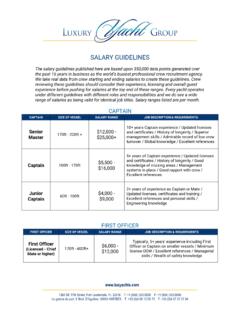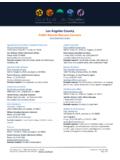Transcription of BY ORDER OF THE SECRETARY AIR FORCE INSTRUCTION 20 …
1 BY ORDER OF THE SECRETARY OF THE AIR FORCE AIR FORCE INSTRUCTION 20-112 6 OCTOBER 2017 Logistics LOGISTICS READINESS QUALITY ASSURANCE PROGRAM (LR QA) COMPLIANCE WITH THIS PUBLICATION IS MANDATORY ACCESSIBILITY: Publications and forms are available on the e-Publishing website at for downloading or ordering RELEASABILITY: There are no releasability restrictions on this publication OPR: AF/A4LR Supersedes: AFI 20-112, 4 February 2015 Certified by: SAF/AQD (Mr. Lawrence S. Kingsley) Pages: 17 This publication implements Air FORCE Policy Directive (AFPD) 63-1, 20-1, Integrated Life Cycle Management. This INSTRUCTION establishes the Logistics Readiness Quality Assurance policy, procedures and guidelines for a standardized, repeatable assessment and evaluation process throughout the United States Air FORCE (USAF) Logistics Readiness community.
2 This INSTRUCTION applies to all Air FORCE Uniformed personnel (Regular, Air FORCE Reserve (AFR) and Air National Guard (ANG)) and civilian personnel. For assistance with interpreting this INSTRUCTION , contact your Major Command (MAJCOM) functional policy activity. ANG units should contact the Air National Guard Readiness Center functional policy section for guidance. Refer recommended changes and questions about this publication to the Office of Primary Responsibility (OPR) using AF Form 847, Recommendation for Change of Publication; route AF Form 847s from the field through the appropriate functional chain of command. This publication may be supplemented at any level, but all Supplements must be routed to the OPR of this publication for coordination prior to certification and approval as outlined in Air FORCE INSTRUCTION (AFI) 33-360, Publications and Forms Management.
3 The authorities to waive wing/unit level requirements in this publication are identified with a Tier ( T-0, T-1, T-2, T-3 ) number following the compliance statement. See AFI 33-360 for a description of the authorities associated with the Tier numbers. Submit requests for waivers through the chain of command to the appropriate Tier waiver approval authority, or alternately, to the Publication OPR for non-tiered compliance items. Ensure that all records created as a result of processes prescribed in this publication are maintained IAW Air FORCE Manual (AFMAN) 33-363, Management of Records, and disposed of IAW Records Disposition Schedule. The use of the name or mark of any specific manufacturer, commercial product, commodity, or service in this publication does not imply endorsement by the Air FORCE . 2 AFI20-112 6 OCTOBER 2017 SUMMARY OF CHANGES This revision includes significant changes to the Logistics Readiness (LR) Quality Assurance Program and must be reviewed in its entirety.
4 Changes include modification of quality assurance evaluator roles, as well as, the removal of the LR QA Structure. Additionally, the removal of the Officer in Charge and Noncommissioned Officer In Charge (NCOIC) duties, aligning Quality Assurance Evaluators (QAEs) under their flights and monthly summary meetings. AFI20-112 6 OCTOBER 2017 3 Chapter 1 GENERAL PURPOSE AND SCOPE Purpose. The purpose of the Logistics Readiness (LR) Quality Assurance (QA) program is to provide the unit commander/civilian director and senior leadership with an assessment of the unit s ability to perform key logistics processes by ensuring standardized, repeatable, technically compliant process execution, while promoting a culture of professional excellence and personal responsibility. The program s primary focus is on personnel proficiency and adherence to established policy and procedures.
5 Scope. The LR QA program is focused on enabling and strengthening commanders mission effectiveness and efficiency. To motivate and promote military discipline, improved unit performance, and manage excellence up and down the chain of command at all levels. To identify issues interfering with readiness, economy, efficiency, discipline, effectiveness, compliance, performance, surety and management excellence. Civil Service Most Efficient Organizations and contracted organizations shall follow the requirements established in their contract s Performance Work Statement (PWS) and the Quality Assurance Surveillance Plan (QASP) for an accepted quality program. 4 AFI20-112 6 OCTOBER 2017 Chapter 2 ROLES AND RESPONSIBILITIES The Quality Assurance Evaluator (QAE), where applicable, are responsible for coordinating compliance actions for their assigned logistics management function, and will be aligned under individual flights within LRS.
6 (T-2). The evaluations will be accomplished by qualified subject matter experts from the various Air FORCE Specialty Codes (AFSC) resident in the LR Activity. (T-2). Air FORCE Reserve Command and National Guard units are authorized to tailor the QAE in ORDER to accomplish the quality assurance function and complete mission requirements. Headquarters Air FORCE Logistics Readiness Division (AF/A4LR & A4LX) will: Develop, articulate, and clarify all Air FORCE LR QA guidance. Develop/maintain/approve Key Task List (KTL) and Routine Inspection List (RIL) pertinent to MAJCOM/AFSC unique requirements via Career Field Education and Training Plan (CFETP). Ensure MAJCOMs utilize LEAP (Logistics Evaluation Assurance Program) as the automated IT/SharePoint to manage all aspects of the program while serving as the central repository.
7 Review effectiveness of the overall LR QA program through metrics pertinent to AFSC unique requirements. Provide funding and sustainment for LEAP. MAJCOM/A4R will: Manage QA programs within the command. Ensure units are executing Key Task List (KTL) and Routine Inspection List (RIL) developed by AF/A4LR/A4LX. Recommend program guidance and administrative changes to AF/A4LR/A4LX. Ensure units are utilizing LEAP as the repository for the LR enterprise. Ensure distribution and posturing for LEAP in collaboration with Program Office and AF/A4LR/A4LX. LR Activities will: Establish a LR QA program. (T-1). Assign a QA Manager. (T-1) QA Manager will manage the unit-level QA Program. (T-1) Ensure Quality Evaluator s are trained IAW Chapter 3 of this publication. (T-1). Ensure the required number of process evaluations are conducted monthly based on the percentages of personnel assigned to the functional area detailed in AFI20-112 6 OCTOBER 2017 5 Attachment 2 and evaluation results are reported to each respective Commander, Flight Chief, Superintendent, and the Training Manager.
8 (T-1). Track all evaluations rated Fail, Technical Data Violation (TDV), Detected Safety Violation (DSV), or Unsatisfactory Condition Report (UCR) until resolved. Comply with the written response policy defined by the Commander, to avoid overdue or overlooked replies. (T-1). Provide a summary of evaluations to LR leadership to include all late replies and repeat findings on a monthly basis. (T-1). Review reported findings for appropriate corrective actions. (T-1). Determine when additional assessments are required in a specific area based upon findings. (T-2). Review and submit unit developed KTL/RIL items to MAJCOM. (T-1). Utilize LEAP as the repository for the AF LR inspections/evaluations. (T-1). LR QA Program will: Evaluate the performance of logistics procedures performed within the organization or falling under the responsibility of the commander/director and report results.
9 (T-1). Make recommendations for improving the effectiveness of all logistics processes. (T-1). Provide functional area inspection and evaluation quotas by type ( , Personnel Evaluations (PEs), Quality Verification Inspections (QVIs), etc.). Incorporate Special Inspections (SI) resulting from cross-tells or determined by Commander driven metrics and designated Special Interest Items. Ensure SIs are reviewed, maintained, and appropriate action(s) taken. Employ RIL/KTL items developed by Headquarters Air FORCE or locally developed to improve effectiveness of logistics processes. Utilize the Career Field Education and Training Plan (CFETP), policy and procedural guidance to evaluate and inspect flights. (T-1). Determine when job guides and manuals associated with assessments, evaluations and inspections are current and available. Notify the appropriate organization (HAF, MAJCOM, Wing, and Group) when deficiencies are found.
10 (T-1). Enter observations, inspections, and evaluation reports into LEAP. (T-1). Track all failed assessments, TDV, DSV, or UCR until resolved within LEAP. (T-1). Customer assistant visits as requested by installation customers, as available and approved by LRS/CC, without impacting required inspection schedules. Provide a developed Monthly QA Evaluation and Inspection Plan. The plan must show the areas, types, and number of assessments, inspections and evaluations that must be conducted over the course of a quarter. The plan will comprise the following to provide QA clear direction for assessing and measuring compliance: (T-1). 6 AFI20-112 6 OCTOBER 2017 Consult with local legal counsel and ensure compliance with federal, state, and local environmental laws/regulations and AF publications. At overseas locations, ensure compliance with Final Governing Standards (FGS) or the Overseas Environmental Baseline Guidance Document in the absence of the FGS.














